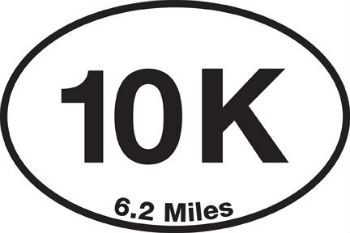Where Have You Gone, 10K?
 Maybe it's just me waxing nostalgic, but doesn't it seem like the 10K has become the redheaded stepchild of the racing world? There are multiple 5Ks every weekend. The half marathon is rapidly becoming a favorite in the running community, and the marathon is, well, the marathon. It's the granddaddy bucket-list race for most runners. But the 10K has gone from the 5K’s wingman to that odd distance that no one trains for or knows how to race. The new breeds of races—color runs, foam runs, warrior dashes—have relegated it to obscurity. It's as if the 10K has been put in a witness protection. Let's save the 10K from extinction.
Maybe it's just me waxing nostalgic, but doesn't it seem like the 10K has become the redheaded stepchild of the racing world? There are multiple 5Ks every weekend. The half marathon is rapidly becoming a favorite in the running community, and the marathon is, well, the marathon. It's the granddaddy bucket-list race for most runners. But the 10K has gone from the 5K’s wingman to that odd distance that no one trains for or knows how to race. The new breeds of races—color runs, foam runs, warrior dashes—have relegated it to obscurity. It's as if the 10K has been put in a witness protection. Let's save the 10K from extinction.
The 10k is a fantastic race, one that deserves a place at the table. The last time an American won an Olympic event on the track further than half a mile was the 1964 games, when Billy Mills pulled off one of the greatest upsets in Olympic History. Guess what event he won?
That's right. The 10K.
Running 6.2 miles is nothing to sneeze at. It's far enough that we need to have a fair fitness level to complete it, but short enough that we have to push ourselves out of that comfortable conversation speed to compete in it. It’s a great balance of speed, strength, endurance, heart, and guile. If you really want to find an event to test yourself, race a 10K.
Training for a 10K is an excellent stepping stone event for those looking to build from 5K training to a half marathon. It allows us to gradually build our training and racing mileage rather than jump to an event over 4x as far as what we've been tackling. Along with being a stepping stone event, it's also great prep work in between half marathon training seasons. Many of us run a spring half and a fall half. The problem is figuring out how to train in between seasons. Most folks tend to go polar. They either do absolutely nothing (or close to it) and then start back over from scratch, or they go to the other end of the spectrum and train like banshees and are fried mentally, emotionally, and physically when it's time to start training again. The 10K works out amazingly well for us to maintain our fitness level without going too crazy one way or another. It's just far enough where you'll need solid training, but not so long that it consumes large amounts of time.
The 10K is an enigma. It takes around an hour to complete and a lifetime to master. Perhaps that is one reason why it has become a forgotten distance. But the 10K just may be that key cog in your training to help you take down some PRs this year.
So how do you train for this unicorn of a race? Funny you should ask. The Fleet Feet 10k Finish program is designed for currently “casual” athletes who are ready to take their training to the next level. The Fleet Feet 10k Fast program is designed for athletes ready to compete 6.2-miles.
 Tim Cary is Head Track & Field and Cross Country for Lindenwood University at Belleville and the former Fleet Feet Assistant Training Manager. Over his more than two decades of coaching, Tim has coached athletes to three national team championships, five national individual championships, two national records, and numerous All-American and All-State honors. Click here to subscribe to our blog.
Tim Cary is Head Track & Field and Cross Country for Lindenwood University at Belleville and the former Fleet Feet Assistant Training Manager. Over his more than two decades of coaching, Tim has coached athletes to three national team championships, five national individual championships, two national records, and numerous All-American and All-State honors. Click here to subscribe to our blog.
Connect With Us
see the latest from Fleet Feet St. Louis